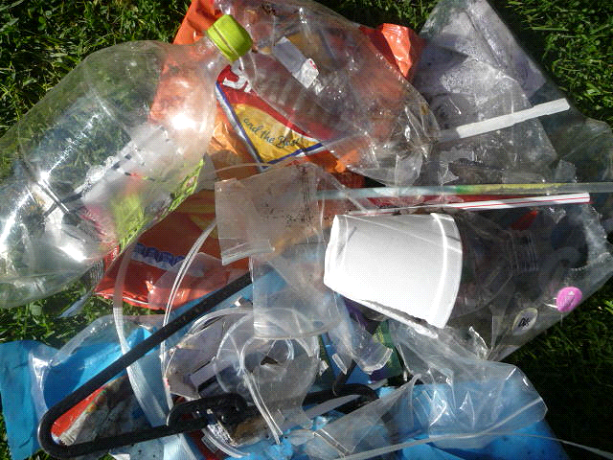Real Product Stewardship has myriad forms
Posted on March 21, 2012 by DrRossH in Plastic Waste NewsReal Product Stewardship has myriad forms | Blogs | Main.
This link relates to a report put out by PWC for the federal government on how to address the problems of lack of recycling and litter that packaging is making on a national basis.
Having been over the RIS report in quite some detail I was dissappointed in its methodology. I have yet to see any self regulating scheme work for any industry. Why would it? Why would companies voluntarily spend spend extra hard earned money for some thing they do not have to do? It doesn’t work and we are fooling ourselves if we think it will. All it would acheive is another 10 years of minor changes with recycling and a worsening problem for litter. Th RIS waas based on the industry saying they would contribute $20m-$60m over the next 23 years. Who verified this number? When you work out what that money could do over 23 years it is not much at all. QLD numbers say it would be about $300m as do SA numbers.
That is simply not enough money to make the changes necessary to achieve the goal. By my crude estimates based on numbers out of WME and other reports it would be at least $300M plus to do this. When you put this into the RSI model it makes the Option 2 BCR approximatley 0.6. Conversely when you put the estimated $1.7b that the containers would raise nationally into the analysis, it gives a CDS scheme a BCR of 1.13 or a net benefit to the economy. Not saying these are exact numbers, but it shows that the RIS numbers can change drastically depending on what is put in the model and it would appear they are heavily biased to a stewardship with a substantially underfunded amount of number of $20m. Why not do a CDS, we know they work for collection of containers very efficiently.
A CDS is a self functioning and self funding scheme.
1) We know the some people in the public will pick up nearly all of the containers. This has no cost and it is the most difficult part because at the consumer level, the containers are spread far and wide making it very difficult to get any paid contractor to retrieve them. Yet the public will do it for free.
2) Business will line up to start and operate the recycle centres. If they got a few cents for every can they delivered back to the reprocessor, that is a $1.3B incentive for businesses to compete for, based on the Victorian numbers. This is a no further cost to the consumer or the local government.
3) There is a point discussed by the bottling companies, that it will cost the consumers an extra 10 cents a container and that is going to damage sales and consumer purchasing power. To put this in perspective, when a Can of Coke for example is purchased from a grocery store or a cafe, the purchaser could not be able to estimate beforehand what the can would cost. It varies tremendously from vendor to vendor. It may be $1 at one place and $4.50 from another. Ten cents would be lost as insignificant in these variations. That is why these CDS are successful. The individual cost added one item is insignificant, but the (publically collected free of charge) total volume of containers is worth a substantial amount to attract businesses to get involved with and process the container back.
Plus let’s not forget the following;
A Newspoll survey taken in 2007 revealed 82 per cent of Australians surveyed are in favour of container deposit legislation (Clean Up Australia 2008, p. 2).
A 2011 Newspoll survey in the Northern Territory showed similar results (Boomerang Alliance 2011).

 How many people today grab a takeaway coffee cup from the local cafe to drink on the go? We don’t know, but the number must be enormous.. Most every one of the above have a plastic top that will last 100s of years. Some cafes still use plastic cups that last a similar time. Is 10 minutes of coffee worth 100s of years of trash?
These items can be seen littering our gutters and on our streets all over the place. If they were all cardboard, they would still be littered, but they would, at least, be gone in a short time.
They do not need to be made of plastic.
How many people today grab a takeaway coffee cup from the local cafe to drink on the go? We don’t know, but the number must be enormous.. Most every one of the above have a plastic top that will last 100s of years. Some cafes still use plastic cups that last a similar time. Is 10 minutes of coffee worth 100s of years of trash?
These items can be seen littering our gutters and on our streets all over the place. If they were all cardboard, they would still be littered, but they would, at least, be gone in a short time.
They do not need to be made of plastic.
 On the way home from the gym last week, a distance of about 1 km (1/2 mile), I counted the items of plastic litter on the curb as I walked. In that short distance I counted 63 pieces of plastic litter. Plastic drink bottles, bottle tops, candy wrappers, plastic film, polystyrene fragments etc. That seemed to be a lot to me. I guess it is a generational thing. Our parents would have been horrified to see that amount, whereas it seems to go unnoticed by our youth of today. In another 20 years how many pieces will there be on this stretch, -- 200? What will today’s youth think of that new amount then when they are older? Will their children be so readily accepting of a higher amount of litter?
On the way home from the gym last week, a distance of about 1 km (1/2 mile), I counted the items of plastic litter on the curb as I walked. In that short distance I counted 63 pieces of plastic litter. Plastic drink bottles, bottle tops, candy wrappers, plastic film, polystyrene fragments etc. That seemed to be a lot to me. I guess it is a generational thing. Our parents would have been horrified to see that amount, whereas it seems to go unnoticed by our youth of today. In another 20 years how many pieces will there be on this stretch, -- 200? What will today’s youth think of that new amount then when they are older? Will their children be so readily accepting of a higher amount of litter?
Udit says:
Post Author April 4, 2012 at 4:41 amThis piece was cgonet, well-written, and pithy.